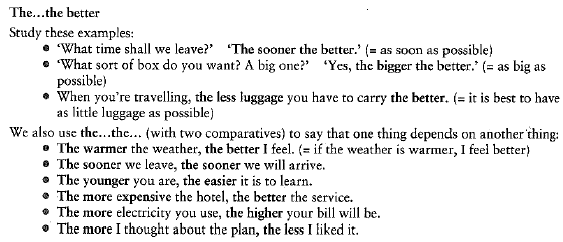
- •7. Different ways of expressing future time.
- •16. What is the difference in presentation of the event by the constructions “used to do” and “would do”?
- •17. The difference between “gone (to)” and “been (to)”?
- •20. Direct and indirect speech.
- •25. Irregular plural nouns.
- •38. Comparative construction.
- •39. Substantivized adjectives.
- •40. Irregular forms of the degrees of comparison of adjectives.
- •41. Adjectives after verbs.
- •47. Word order – adverbs with a verb.
- •48. Semantic groups of pronouns.
- •49. Number and case forms of pronouns.
- •50. Forms of “other”.
- •51. Expressions of quantity.
- •56. What may prepositions indicate?
- •58. How can prepositions be classified in accordance with their structure?
- •63. “For, during and while” – grammatical difference.
- •79. Usage of articles with the names of countries, mountains, islands.
- •80. Usage of articles with the names of oceans, seas, rivers, lakes.
- •1.2.2. Voice
- •1.2.3. Aspect
- •85. Infinitive constructions. Complex Subject. Complex Object. For – Construction.
- •1. The objective with the infinitive construction
- •1) The subject
- •87. What is Gerund? How to distinguish it from the Participle 1 and the Verbal Noun? How to translate the Gerund into Russian?
- •88. What is the Participle 1? How to translate it into Russian?
- •89. What is the Participle 2? The functions of the Participle 2 in the sentence?
- •1. Attribute.
- •2. Adverbial Modifier
- •3. Predicative
- •90. Parenthesis. Dangling or Misrelated Participle.
- •91. Constructions with the Participle
- •92. Gerundial Constructions
- •93. The Infinitive. The syntactical and morphological features of the Infinitive.
- •II. The morphological features of the infinitive (The forms of the infinitive)
- •97. What verbals can be used as subject or object?
- •98. What are the verbs which can be followed by –ing or to with a difference of meaning?
38. Comparative construction.






39. Substantivized adjectives.
The adjective is sometimes substantivized, it is used in this case to denote a group of objects or an object possessing the quality. The adjectives may be substantivized fully or partially.
Partially substantivized adjectives often denote the following:
a class of persons possessing the same quality
the old, the young, the rich, the poor, the aged, the unemployed, the wounded, the sick, etc.;
nationalities
the English, the French, the Dutch;
abstract notions
the beautiful, the plural, the impossible, the inevitable, etc.
What are the gaieties of the rich, the splendour of the powerful, what is the pride of the great? (Hx.)
They co-occur in the text with the definite article.
Wholly substantivized adjectives may denote:
persons
a relative, a conservative, a native, a savage, a criminal, a European, a liberal, a progressive, etc.
nationalities
a Russian, a German, an Italian, an American, etc.
objects with a collective meaning (used only in the plural)
goods, valuables, sweets, eatables, etc.
They are used in the plural and the genitive case forms and co-occur with articles like nouns.
And now they were in the midst of the Market's clamour. Greeks, Italians, French, Negroes, Indians. (Frb.)
40. Irregular forms of the degrees of comparison of adjectives.
|
Positive degree |
Comparative degree |
Superlative degree |
Difference in meaning |
|
1 |
2 |
3 |
4 |
|
good |
better |
best |
|
|
well (relating to health) |
|
|
|
|
bad (ill) |
worse |
worst |
|
|
old |
older |
oldest |
|
|
|
elder |
eldest |
Used with reference to membership of a human family or social group |
|
late |
later |
latest |
Used with reference to time |
|
|
latter |
last |
Used with reference to the order of events |
|
near |
nearer |
nearest |
Used with reference to distance |
|
|
|
next |
Used with reference to order |
|
far |
farther |
farthest |
Both used with reference to distance, though in this sense "farther", "farthest" are preferred. "Further" is preferred in the sense of "another", it shows that something will follow |
|
|
furthest |
further |
|
41. Adjectives after verbs.

47. Word order – adverbs with a verb.





48. Semantic groups of pronouns.
Pronouns, unlike nouns or adjectives, do not denote substances or qualities, but they refer to the substances or qualities expressed by nouns and adjectives in the same context or situation.
Peter went to Mary’s place yesterday.
He went to her place yesterday as he wanted to tell her the news.
According to their meaning pronouns are generally subdivided into:
Personal
I, you, he, she, it, we, they.
Possessive
My (mine), your (yours), her, his, its, our, your, their.
Demonstrative
This, that, these, those.
Indefinite
Each, either, both, some, any, every, one, everyone, everybody, everything, anyone, anybody, anything, all, many, much, few, little, other, another.
Negative
Neither, nobody, nothing, none, no one.
Reflexive
Myself, yourself, himself, herself, itself, ourselves, yourselves, themselves.
Interrogative
Who, what, whose, which, whom, whoever, whichever, whatever.
Reciprocal
Each other, one another.
Connective (are used to connect the subordinate clause to the principal clause)
Who, whom, which, whose, that.
